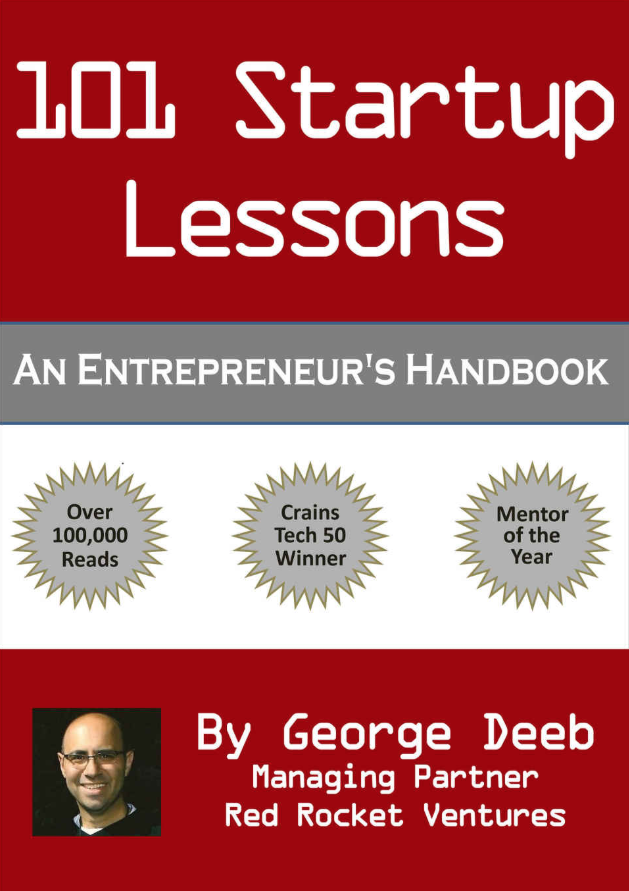What you do today will drive next year’s revenue. So, if you are looking to successfully grow and scale your business, George Deeb, Managing Partner at Red Rocket Ventures, Forbes contributor, and author says “it’s all math!” Today on the Atlanta Small Business Show, George joins us to share ways you can scale your revenue.
Since starting at Red Rocket in 2010, Deeb has advised or mentored over 750 B2C and B2B businesses. He has a large network of contacts in the startup, digital, and venture capital communities and specializes in business planning, growth strategy, corporate development, fundraising, sales, and marketing.
Jim Fitzpatrick:
So thank you for joining us once again on the show.
George Deeb:
Great being here, Jim.
Jim Fitzpatrick:
Sure. So talk to us about this. How do you successfully scale revenues? You have everybody’s attention, by the way, on this.
George Deeb:
It’s interesting how many people actually don’t do the planning to ensure that they hit next year’s revenues. But if you’re doing the proper planning, you said it in the intro. It’s all about the math. Do the numbers credibly add up to the goal? And if they do, you’re in great shape. And if they don’t, you got some fixing to do.
Jim Fitzpatrick:
How come we don’t do this? Are we afraid of what the numbers might tell us when we add it up? It might come in brackets or it might come in with a minus in front of it and go, uh-oh.
George Deeb:
Well, I think a lot of it has to do with the entrepreneur that’s getting the business off the ground. Let’s say you’re a technologist and you’re great at coding and building technology, you don’t really know how to run a business very well. You haven’t been trained in that. You didn’t go to school for that. Your brain isn’t thinking the financial statements and the budgets and the growth of the business. So it really is a skill set all of a own that you really need to sharpen at home.
Jim Fitzpatrick:
Yeah, there’s no question because in many cases with entrepreneurs too, if they’ve been in the business a year or maybe two years, they don’t know. And I think, to your point, they don’t know what next year is going to bring. So they just kind of go through it haphazardly and go, well, let’s see if we make $1,000 in January or we make 10,000 or we make 100,000 you don’t really know. But to put it pen to paper, so to speak, I’m aging myself here when we used to use pens instead of typing, but to put pen to paper and say, okay, this is going to be our forecast and here’s how we’re going to get there. And by the way, not just on the top line, and I know we’re probably going to get into it, but also what the expenses are. What are the typical drivers of scaling revenues?
George Deeb:
Yeah, there’s several things to think about here. And it’s important to make the distinction between a B2C business and a B2B business. Because many B2C businesses that are facing consumers, those are marketing driven businesses for the most part. You’re going to put some advertising into the market, you’re going to spend a certain amount of budget and that should drive a certain amount of impressions and clicks and sales from that advertising exposure.
B2B is typically sales driven, for the most part, it’s outbound sales and do an account where a sales team is calling into those relationships. And it’s often a longer sales cycle and making sure you got enough salespeople out there making the calls to hit the numbers. So I wanted to make that distinction first.
But it really comes down to a few things. Number one, you can be growing your existing business just with the existing products you have, that’s one way. Maybe you haven’t fully tapped out your market yet, and there’s additional market share to be had, that’s road number one.
Road number two is, there may be new markets you could get into, maybe your product was selling into the healthcare industry and it could equally be sold into the automotive industry. Open up a new market for your business and it’ll potentially double your revenues in the process.
The third path would be, maybe it’s an additional product. Maybe you’d have product X in the market, and if you have product Y or product Z, that’s the ability to double or triple your revenues. Do you have enough products in the market to reasonably hit your goal
And then the last category is more about what regions are you operating? Are you only selling into the United States? Have you gotten to the point you could be selling into Europe or Asia? How does international take a play in terms of internally growing your business? And that doesn’t even talk about M&A, or mergers and acquisitions, for external growth.
Jim Fitzpatrick:
And also eCommerce, right? I mean, that’s got to be considered in there as well, what you can do online.
George Deeb:
Yeah, for sure. Surprised many people don’t think about the power of the internet or what it can be doing for you. My other business, I sell furniture to restaurants and that industry has largely been an offline walk into a brick and mortar dealer, buy that kind of product. The customers today didn’t even know you could be buying this kind of product online. And if you’re an early mover into that market, you could own it and have a tremendous success growing your revenues.
Jim Fitzpatrick:
That’s right. It’s so much easier for that end user to be able to go online rather than having to take the time out of their busy schedule, in the case of restaurant owners, now I got to go down to some warehouse someplace or so, some showroom to pick this out and pick colors and everything else when you can do it right there online in your case.
George Deeb:
Yeah, the internet has changed everything, that’s for sure.
Jim Fitzpatrick:
Boy, no question about it. And especially coming out of COVID where everybody during COVID turned to the internet and said, wow, I can’t believe all of the things I could’ve been doing from home all of this time. So we’re kind of focused on that now. Can you walk us through an example of how math helps you scale revenues?
George Deeb:
Yeah, for sure. Let’s just pretend you’re a 50 million revenue company and you’re trying to grow to 100 million revenues. There are several ways you can do that. Number one, maybe you need to add 50 new salespeople each selling a million dollars in sales each. And that incremental $50 million from those 50 new hires is how you’re going to grow your revenues from 50 to 100. That’s one example.
Second example is, let’s say there’s a competitor in the market and you want to buy that competitor and that competitor’s the same size as you are, and when you take your 50 million in revenue and put it together with their 50 million in revenue, with a snap of a finger, now you’re up to $100 million in revenue. That would be a second example of making the math work.
We talked about adding a second product line. If you have one product line that’s worth 50 million in revenue, maybe adding that second product line could be an equal $50 million in revenue to take your business to the next level. So there’s a lot of different ways you can do it and there’s not one right answer, but as long as the math works you’re in good shape.
Jim Fitzpatrick:
It’s important not to lie to yourself as a business owner to say, look, I’m not going to buy another company and I’m not going to launch another product line per se, maybe for whatever reason, you can’t get to it quick enough, you don’t know what the product line is. But George, I’m going to have my sales people sell double what they sold in 2023 versus 2022. It’s a fat lie that you’re telling yourself, right?
George Deeb:
Well, for sure. I mean, the capacity of one salesperson is as many phone calls as they can make in the course of a day. They’re already fully going guns blazing for their existing million dollars in revenues they have. You’re never going to get $2 million out of that same salesperson with that same kind of sales cycle and sales process. But if you had a second salesperson, now you’ve got the capacity to grow into.
Jim Fitzpatrick:
That’s right. And keeping along the lines of the whole concept of math. If it takes you three months or four months to get a salesperson up and running, trained and understanding your product line and being able to be customer facing, don’t do that in January because that person’s not going to get online until maybe April or May. You’re already halfway through the year. So you can’t really take those revenues into account. You got to start now in September, October of 2022 in order to have those other sales people up and running and in their territories and in the ongoing training I should say, but in the seats to be able to make those calls and make those presentations. This isn’t something that you do on January one.
George Deeb:
What you’re talking about is the math not only needs to work in the aggregate value of the revenues, the math needs to work from the calendar of the year. Where are you and your development career? How long is it going to take you to hire that new person and train that new person and onboard that new person? And oh, by the way, if the model says you need 50 new salespeople to hit your $100 million goal, you probably need to recruit, I don’t know, 75 or 80. Because not all of those 50 are going to work out and there’s going to be attrition along the way that you have to budget for.
Jim Fitzpatrick:
That’s right. If we haven’t scared you off enough, entrepreneurs and business owners, if you would, George, give us a few more examples of how to sharpen your pencil and really make the math work for you.
George Deeb:
Well, I mean, you gave the example on the recruitment. You have to make sure you’re hiring far enough ahead. The same thing could be happening on the product development side. So, if you’re trying to launch that second product into market and that’s going to be your solution to doubling your revenues, it could take you two years to get a new product developed and tested and into the market and starting to get it sold before it actually starts to drive penny number one of revenue. So, you need to be planning far enough ahead.
So if your goal is I need to get to $100 million not in this year or next year, but by the year after, that second product could be a reasonable path forward. But if you need those revenues now and you’ve got a gun to your head and your board is screaming for revenues now, that new product is not going to be the answer unless you acquire it.
Jim Fitzpatrick:
That’s right. How does math come into play when studying your industry?
George Deeb:
Yeah. Well, I mean, the first thing you got to do before you launch any business is kind of size the market and kind of see what you’re up against. Let’s use an example where maybe that you’re in a small industry that only has $300 million worth of potential market size. If there’s four competitors that are in that market and they all reasonably have a chance of getting to 75 million in revenue. And your goal is to get to 100 there’s not enough market to be had for you to reasonably get to that 100 million point. So you’re going to have to be looking for other things to be doing because your market is too small in the current product or service that you’re offering, that would be a perfect example.
Jim Fitzpatrick:
Sure. So keep those objectives realistic and based on your research of what the market. Rather than just being willy-nilly about it, say, we want to increase by another 50 million a year or 25 million a year, how are you going to get there? Well, we’ll just get more salespeople and sell more. I mean, there’s got to be more of a science to it than what you just…
George Deeb:
That’s exactly what we’re saying.
Jim Fitzpatrick:
Are there other issues to consider beyond just the math when scaling revenues quickly?
George Deeb:
Yeah, there are several things. I mean, obviously any rapid growth company have to deal with these kind of issues. But things like you don’t want to start hitting the accelerator until you’re ready to hit the accelerator. What I mean by that is you don’t want the wheels of the bus to fall off at exactly the same time you’re pouring the kerosene on the fire. So do you have the right processes in place? Do you have the right training procedures in place? Can your culture handle a doubling of growth without everybody driving each other crazy? So you don’t want to just grow for growth, say you got to make sure the business can handle it. That’s one thing.
A second thing would be make sure you shorten your training curve by hiring people that know your industry. So this is another example of how to make the math work. If you’re hiring a brand new person from a different industry, the training curve will be twice as long as if you’re hiring somebody in your industry. So if you’re in a race for it, well, you need people that know your market and have those relationships now because they can hit the ground running. That would be another example.
The last example I’d give is don’t launch any rapid growth exercise unless you’ve got the proper metrics and reporting in place. You want to be able to track your success over time and build those KPIs into your monthly reports so you can see how many new accounts have we reached out to? Of those accounts, how many are in our active opportunities that might turn into revenues? Of those, how many have turned into contracts and revenue so you can actually track the success of your sales people along the way?
Jim Fitzpatrick:
Right. So vitally important, you can’t just do a set it and forget it and visit it quarterly. It’s got to be something you’re doing, if not daily, then weekly.
George Deeb:
For sure. And it’s not the type of thing you can just put on the back renter and hope it all works out. You got to religiously push it and making sure the team is all religiously focused on the goal and knows the key actions that they need to take in order to hit that goal.
Jim Fitzpatrick:
That’s right. And we haven’t even touched really on supply chain, but that’s such a big issue right now, you might have product to support 50 million in sales, you want to get to 100 million in sales, but in terms of the supply chain, could you live up to that 100 million, that extra 50 with the product available to you? Because you might turn around and say, well yeah, we have the sales for it, we’re able to write that, but we can’t get it in the back door, we can’t get it in the warehouse to get it out.
George Deeb:
You’re raising a great point. Before you launch this big major endeavor to double your sales, you need to speak to your vendors and make sure that they can support the doubling of your sales. I mean, we’re going to one of those exercises with our own company and the first thing we did was we called each of our vendors and said, hey listen, we’re thinking about doubling revenues. What will that do to you? Do you need to add additional production capacity or a second shift of employees or whatever it is. And they have to have the plan to get you the products you need in the timely fashion for you to hit your goals.
Jim Fitzpatrick:
That’s right. Any final words of wisdom on this topic?
George Deeb:
Well, I love this concept of growth is all math, because it really is. I spoke to a very successful entrepreneur that was involved in a scaling of a business from zero to a billion in revenue in a few years period of time. And I was asking him the question, well how did you do that mean? What words of wisdom would you bring to your listening mentors or listening mentees? He said that it’s all math, as long as the math works you’ll get there. So I love that concept.
But make sure you’re planning far enough ahead. They have the right stepping stones in place that what those key inflection points are going to be along the way to getting to that goal with reasonable assumptions. They can’t be aggressive pie in the sky, they got to be reasonable assumptions you can actually hit with a long enough timeline to get there. If you’re lucky the math will work.
Jim Fitzpatrick:
That’s right. And I might add that sometimes this kind of growth, in fact most times, it also comes with expense. So you also have to do the math on that side too. You can’t just sit in a conference room and say, hey, guess what? We’re going to double our business and we’re going to maybe make some fundamental changes here along the way. But manpower costs more money or maybe product costs more money or marketing costs more money. Have you done the math on that before you go ahead and say, okay, here’s how we’re going to do this and then your board turns to you or maybe your spouse or your partner and says, really, where’s that coming from? So that’s probably part of the first exercise you do is, how much do we have available to us to go ahead and make this commitment to increase our business?
George Deeb:
Yeah. You got to make sure you’ve got the whole right process in place to make this work, because if you don’t, you’re in big trouble and I agree with 100% of what you just said.
Jim Fitzpatrick:
Yeah, yeah. Well that’s for sure. George Deeb, managing partner, Red Rock Ventures. Thank you once again for joining us on the show. Your insights are invaluable to so many that listen to us and have these conversations each month or each week, these months seem to be going by so quickly. It’s amazing that we’re coming to the end now, or at least the last quarter of 2022. You say, my gosh, where did it go?
George Deeb:
We just looked at the calendar and said we’re in September already and I got, oh my God. I just feel like the year just started and we’re already planning our holiday Christmas party.
Jim Fitzpatrick:
Exactly right.
George Deeb:
It’s crazy.
Jim Fitzpatrick:
Unbelievable. So today everybody’s got to come back into the office for a holiday Christmas party because nobody works in the office anymore. And they’re like, ah, okay, I’ll come back.
George Deeb:
You need something to bring him back in. If there’s a good steak dinner waiting for them, that’s a good draw.
Jim Fitzpatrick:
That’s right. All right, George, thanks so much for joining us. Appreciate it.
George Deeb:
Thanks. Great seeing you, Jim.
The Atlanta Small Business Network, from start-up to success, we are your go-to resource for small business news, expert advice, information, and event coverage.
While you’re here, don’t forget to subscribe to our email newsletter for all the latest business news know-how from Atlanta Small Business Network.








